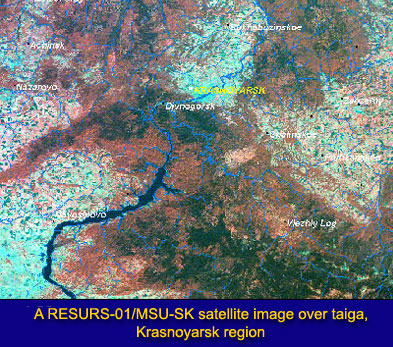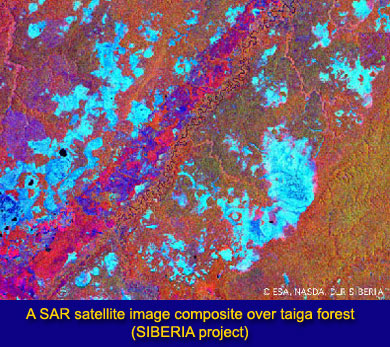| MAIN |
| ABOUT A PROJECT |
| OBJECTIVES |
| TEST REGIONS |
| DATA BASES |
| STUDY RESULTS |
| REPORTS |
| CONTACTS |
 |
Importance of Siberian forest
The increasing concentration of atmospheric CO2 and associated climate change require the detailed study of carbon balance/flux in forest ecosystems. The boreal forest region, (most of which is in Russia, particularly Siberia), occupies about 17 % of the earth's land surface area and its role in the global climate change processes is very important but still not well understood.Russia's forests represent:
-about 22 % of the forested area and 21 % of volume of the wood resources of the planet
-about 15 % of the above-ground carbon stocks and 75 % of the total carbon stocks of the boreal forest zone
-significant contribution to the global atmospheric carbon fluxes
The state and evolution of the Russian forests is thus of major national, European and global significance. Following the political transformation of the former Soviet Union into the Commonwealth of Independent States, the Eurasian region of Russia has received increased attention because of the potential impact of new policies related to the management and exploitation of these highly valuable resources.




Needs to improve existing information on Siberian forests at national level
The current methods for carbon pool and fluxes assessment of Russian forest at national and sub-national levels are based on a database including: forested and non-forested land categories, forest species and age structure, and dynamic processes. But this country-wide forest information is only available at the level of the forestry management units (see figure) and is only revised every five-years. In some regions this forest inventory information was derived from aerial visual inspection conducted in the 1950's. In particular the Northern and Far Eastern Siberian regions are characterized by coarse geographical and very old descriptions of the forest resources. Natural and anthropogenic fires, clear-cutting, insect damage and industrial pollution are some of the main factors causing change in the Siberian forest ecosystems. Accounting is needed to assess the boreal forests contribution to the global carbon balance and for characterising these disturbances. In addition to commercial forest activities, reforestation and natural growing processes should also be well characterized. Due to absence of a system that integrates all necessary data about natural and anthropogenic processes the existing assessments of the carbon stocks and fluxes of the Russian forests are uncertain.The Main Components of the Eurasian Forest Monitoring System
The general structure of the Eurasian forest monitoring system will include four modules, which are briefly presented below.The satellite data collection module
The following satellite data sources offer near-real time data for the whole region:
- the network of NOAA-AVHRR data local receiving stations (which is increasing in number)
- data from the Spot 4-Vegetation instrument (from 1998)
- data from the MODIS instrument on the EOS platform


- the NASDA (Japan) JERS-1 coverage of Eurasia (1997) will provide wall to wall coverage in the L band radar.
- ERS SAR data from ESA and acquired by the DLR (Germany) will provide C band radar coverage over the Central part of Siberia (1997-1998)
Optical High-resolution sources: the SPOT and Landsat TM images will be used to quantify rate of change and assure reliability.
The data analysis module will include three thematically oriented activities, namely:
- the forest cover mapping activity using optical coarse (NOAA/AVHRR, SPOT4 /VEGETATION) and medium (RESURS-O1/MSU-SK) spatial resolution satellite imagery, and using medium resolution products derived from fine spatial resolution radar data (ERS/SAR, JERS/SAR);
- the forest monitoring activity using high time-frequency imagery of coarse resolution satellite sensors for the most significant areas of rapid forest cover change, and high resolution imagery for quantitative estimation of change
- the forest fire monitoring activity will be a topic of intense observation and analysis as fires is a ecological factor of major importance in the dynamics of boreal forests. The network of local stations will provide a near-real time capability for fire tracking.
Eurasian Information System module
It is foreseen that the current effort will give rise to the establishment of a new Eurasian Forest Information System (EFIS) for the archiving and management of spatial processed data and products from a range of sources, as well as for user access, including remote access through Internet facilities. The existing GIS databases on Siberian vegetation will be incorporated as one main first component of the EFIS.
Carbon assessment module
The carbon assessment module will provide an opportunity to assess of carbon pool and fluxes based on a range of models and algorithms adapted to use remote sensing derived parameters of forest cover and its dynamic as input variables. The spatial data held in EFIS will be particularly valuable in upscaling flux measurements made at the existing network of in-situ flux towers.